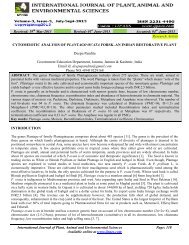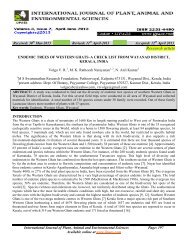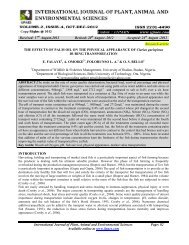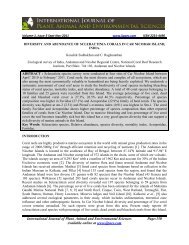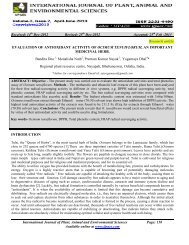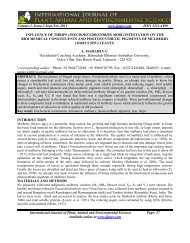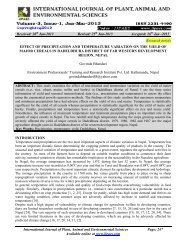biobleaching and delignification of hard wood kraft pulp ... - Ijpaes.com
biobleaching and delignification of hard wood kraft pulp ... - Ijpaes.com
biobleaching and delignification of hard wood kraft pulp ... - Ijpaes.com
You also want an ePaper? Increase the reach of your titles
YUMPU automatically turns print PDFs into web optimized ePapers that Google loves.
Selvam <strong>and</strong> Arung<strong>and</strong>hi Copyrights@2013 IJPAES ISSN 2231-4490<br />
Preparation <strong>of</strong> h<strong>and</strong> sheet<br />
To prepare the h<strong>and</strong> sheets (2x4 cm size), the <strong>pulp</strong> suspension was filtered through a Buchner funnel vacuum. The<br />
residue was blotted <strong>and</strong> air dried for 24 h.<br />
Kappa number (TAPPI, 1993)<br />
Kappa number is used as criteria for the lignin content <strong>of</strong> <strong>pulp</strong>s <strong>and</strong> is determined as the volume <strong>of</strong> 0.1 N<br />
potassium permanganate (ml) consumed by 1.0 g <strong>of</strong> moisture free <strong>pulp</strong>. A portion <strong>of</strong> the cut piece <strong>of</strong> h<strong>and</strong> sheets<br />
that could consume approximately 50 per cent <strong>of</strong> potassium permanganate solution (0.1%) was weighted out <strong>and</strong><br />
disintegrated in 500 ml distilled water until free <strong>of</strong> fibre clots or bundles. The disintegrated suspension was made up<br />
to 800 ml. To 100 ml <strong>of</strong> KMnO 4 solution (0.1 N), 100 ml <strong>of</strong> H 2 SO 4 (4 N) was added <strong>and</strong> cooled to 25°C <strong>and</strong><br />
immediately added to disintegrated h<strong>and</strong> sheet suspension. After 10 min, the reaction was stopped by adding 20 ml <strong>of</strong><br />
potassium iodide solution (1 N) <strong>and</strong> titrated against sodium thiosulphate solution (0.2 N). Starch solution (0.2 %) was<br />
used as the indicator. A blank titration was carried out in the same procedure but without <strong>pulp</strong>. The kappa number was<br />
calculated by the formula<br />
K= p x f / W<br />
<strong>and</strong><br />
P = (b-a) N / 0.1<br />
Where,<br />
K = Kappa number<br />
F = Factor for correction to the 50 per cent permanganate consumption<br />
depending on the volume <strong>of</strong> <strong>pulp</strong> (TAPPI, 1993)<br />
W = Weight <strong>of</strong> moisture free <strong>pulp</strong> sample used for estimation (g)<br />
P = Amount <strong>of</strong> 0.1 N permanganate consumed by the sample (ml)<br />
B = Amount <strong>of</strong> thiosulphate consumed in blank determination (ml)<br />
A = Amount <strong>of</strong> thiosulphate consumed by sample<br />
N = Normality <strong>of</strong> thiosulphate<br />
Correction for reaction temperature<br />
Pf<br />
K= ------ [0.0+0.013(25-t)]<br />
W<br />
Where,<br />
t = actual reaction temperature in degree Celsius.<br />
Brightness<br />
Brightness <strong>of</strong> the h<strong>and</strong> sheets were measured at 457 nm in a Perkin Elmer λ3B spectrophotometer equipped with a<br />
reflectance sphere.<br />
RESULTS AND DISCUSSION<br />
The results showed in table 1 <strong>and</strong> figure I, explained the treatment <strong>of</strong> HWKP by white rot fungi. The parameters were<br />
analysed for pH, kappa number <strong>and</strong> brightness (ISO units). The initial pH <strong>of</strong> the HWKP was 6.93, Kappa number was<br />
28.00 <strong>and</strong> brightness was 31.50 ISO units. In Trametes sp. treatment, HWKP pH had reduced to 4.59 from 6.93 after<br />
10 days <strong>of</strong> incubation period also the kappa number was reduced to 14.72 from 28.00, then the brightness was<br />
increased from 31.50 to 43.01 ISO Units. On the 10 th day <strong>of</strong> incubation period Ganoderma sp. reduced the pH 4.67<br />
from 6.93, Kappa number was reduced to 13.89 on the same day, brightness was increased up to 43.98 from 31.50<br />
ISO units. For Poria sp. the pH <strong>and</strong> kappa number had reduced to 4.36 <strong>and</strong> 12.76 ISO Units respectively. Increased<br />
brightness (44.87 ISO units) was observed on 10 th day. [10]. The pine <strong>kraft</strong> <strong>pulp</strong> was bleached in a totally chlorine<br />
free sequence that involved treatment with culture supernatant from white rot fungus Trametes troggi where as <strong>kraft</strong><br />
<strong>pulp</strong> from Eucalyptus globules was treated by Pycnoporus sanguienus at 40°C on pH 3.0 [17]. T. versicolor was<br />
shown to be capable <strong>of</strong> substantial depolarization <strong>and</strong> <strong>delignification</strong> <strong>of</strong> unbleached industrial <strong>kraft</strong> <strong>pulp</strong>s over 2 to 5<br />
days [18].<br />
International Journal <strong>of</strong> Plant, Animal <strong>and</strong> Environmental Sciences Page: 98<br />
Available online at www.ijpaes.<strong>com</strong>



